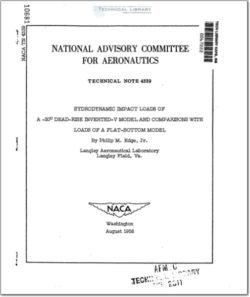NACA-TN-4339

- Version
- 162 Downloads
- 1,009.54 KB File Size
- 1 File Count
- March 24, 2016 Create Date
- March 24, 2016 Last Updated
National Advisory Committee for Aeronautics, Technical Notes - Hydrodynamic Impact Loads of a -20° Dead-Rise Inverted-V Model and Comparisons with Loads of a Flat-Bottom Model

As part of a study of hydrodynamic impact loads on chine—immersed
bodies, a model having an invertedJV transverse shape and a dead-rise
angle of -20° was tested at the Langley impact basin. A series of fixed-
trim impacts of this inverted—V model were made in smooth water over a
wide range of trim and initial flight-path angles at a beam-loading
coefficient of 19.15 with a few impacts at beam-loading coefficients of
27.90 and 56.07.
The data are presented in tables and in figures as variations of
loads and motions (in coefficient form) with time, trim angle, and
flight—path angle. In general, the maximum impact loads experienced by
the invertedrV model were greater than the loads which have been obtained
for a flatAbottom model; however, for the severe impact conditions
approaching Oo trim.(flat impacts) a trend toward smaller loads than
those experienced on a flat bottom is indicated. Peak pressures for the
invertedJV transverse shape compare with those for the flat4bottom model
in a manner similar to the maximum impact loads.
Investigations of hydrodynamic impact loads on chine-immersed bodies
at the Langley impact basin have included several transverse shapes
(refs. 1 to A). Reference 1 presented loads for a flat-bottom (0° dead-
rise angle) model and references 2 to h presented loads for models having
positive dead-rise angles_and V and curved transverse shapes. These
investigations have indicated the relation of maximum loads to transverse
shape for chine-immersed models of zero and positive dead-rise angles.
The present investigation extends this study beyond the flat plate to
the inverted-V shape with a -20° dead-rise angle.
Configurations having negative dead-rise angles are of interest
from the standpoint of the unconventional flow of water from the instant
of initial contact as compared with impacts of bodies having positive
dead-rise angles. The flow upon initial contact of the model having a
negative dead-rise angle is from the chines inward toward the center or
keel of the bottom as contrasted with that of the model having a posi—
tive dead-rise angle which is outward from the keel.
| File | Action |
|---|---|
| naca-tn-4339 Hydrodynamic Impact Loads of a -20° Dead-Rise Inverted-V Model and Comparisons with Loads of a Flat-Bottom Model.pdf | Download |

Comment On This Post